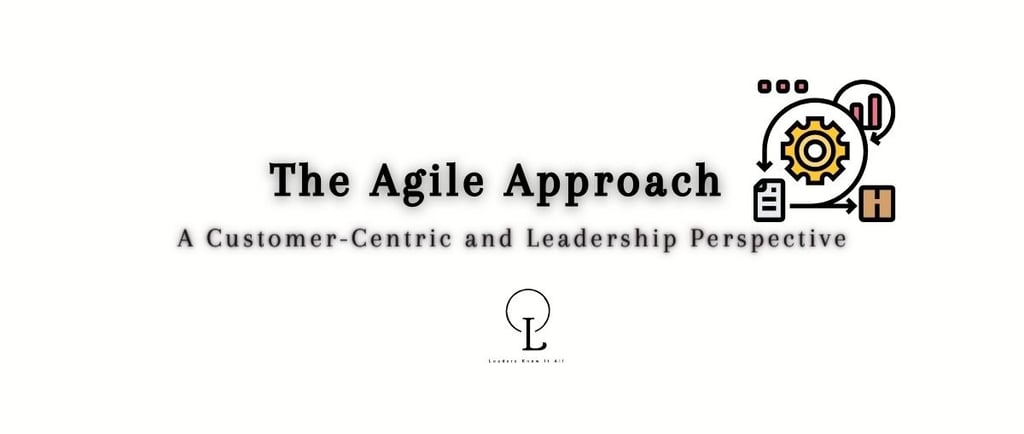The Agile Approach: A Customer-Centric and Leadership Perspective
In today's fast-paced and ever-changing business landscape, organizations are constantly seeking ways to improve their processes and deliver value to their customers more efficiently. One approach that has gained significant popularity is the Agile approach. This customer-centric methodology has revolutionized the way businesses operate, enabling them to respond quickly to customer needs and adapt to market dynamics. In this article, we will explore the Agile approach, its customer-centric nature, and how it can be applied to leadership.
SKILL DEVELOPMENTMANAGEMENT SKILLSAGILE APPROACHEFFECTIVE LEADERSHIPLEADERSHIP SKILLS
leaders know it all
1/20/20243 min read


In today's fast-paced and ever-changing business landscape, organizations are constantly seeking ways to improve their processes and deliver value to their customers more efficiently. One approach that has gained significant popularity is the Agile approach. This customer-centric methodology has revolutionized the way businesses operate, enabling them to respond quickly to customer needs and adapt to market dynamics. In this article, we will explore the Agile approach, its customer-centric nature, and how it can be applied to leadership.
Understanding the Agile Approach
The Agile approach is a project management and software development methodology that emphasizes collaboration, flexibility, and iterative progress. Unlike traditional waterfall methods, which follow a linear sequence of phases, Agile focuses on delivering work in small, incremental iterations called sprints. This iterative process allows for feedback and adjustments along the way, ensuring that the final product meets the customer's evolving requirements.
At the core of the Agile approach is the concept of customer collaboration. Agile teams work closely with customers and stakeholders to understand their needs and incorporate their feedback throughout the development process. This customer-centric approach ensures that the end product aligns with the customer's expectations and delivers maximum value.
The Customer-Centric Nature of Agile
Agile methodologies prioritize customer satisfaction by placing the customer at the center of the development process. Here are some key aspects that make Agile customer-centric:
1. Continuous Customer Involvement
Agile teams actively involve customers and stakeholders throughout the project lifecycle. By engaging customers in regular meetings and discussions, Agile teams gain valuable insights into their needs, preferences, and priorities. This continuous involvement helps in building a product that truly addresses the customer's requirements, leading to higher customer satisfaction.
2. Iterative Development and Feedback Loops
The Agile approach breaks down the development process into small iterations or sprints. At the end of each sprint, the team seeks feedback from the customer and stakeholders. This feedback loop allows for quick adjustments and course corrections, ensuring that the final product meets the customer's expectations. By incorporating feedback early and often, Agile teams can minimize the risk of developing a product that does not align with customer needs.
3. Prioritization of Customer Value
Agile teams focus on delivering value to the customer in every iteration. They prioritize features and functionalities based on customer needs and business value. This approach ensures that the most critical and valuable features are developed first, enabling the customer to start realizing value early in the development process.
4. Embracing Change
Unlike traditional methodologies, which resist changes once the requirements are defined, Agile embraces change as a natural part of the development process. Customer needs and market dynamics can change rapidly, and Agile teams are equipped to adapt quickly. They welcome changes in requirements and incorporate them into the ongoing development, ensuring that the end product remains relevant and valuable to the customer.
The Agile Approach of Leadership
Agile principles are not limited to software development teams alone. The Agile approach can also be applied to leadership, enabling leaders to create a more adaptive and customer-centric organizational culture. Here are some key aspects of the Agile approach of leadership:
1. Empowering and Trusting Teams
In Agile leadership, leaders empower and trust their teams to make decisions and take ownership of their work. This decentralized decision-making process fosters a culture of collaboration and innovation, allowing teams to respond quickly to customer needs and market changes. Leaders act as facilitators and coaches, providing guidance and support to their teams.
2. Facilitating Continuous Learning
Agile leaders encourage a culture of continuous learning and improvement. They create an environment where teams feel safe to experiment, learn from failures, and adapt their approaches. By promoting a growth mindset and providing opportunities for skill development, Agile leaders enable their teams to stay ahead in a rapidly evolving business landscape.
3. Promoting Transparency and Communication
Agile leaders prioritize transparent communication within the organization. They ensure that information flows freely across teams and departments, facilitating collaboration and alignment. By fostering open and honest communication, leaders can gather valuable insights from employees and customers, enabling them to make informed decisions and drive customer-centric initiatives.
4. Embracing Agility in Decision-Making
Agile leaders embrace an iterative and adaptive approach to decision-making. They understand that decisions need to be made quickly and based on the available information. Rather than waiting for a perfect solution, Agile leaders make informed decisions, monitor the outcomes, and adjust their strategies as needed. This agility in decision-making enables leaders to respond swiftly to customer needs and changing market conditions.
Conclusion
The Agile approach is not just a project management methodology; it is a mindset that prioritizes customer satisfaction, collaboration, and adaptability. By adopting the Agile approach, organizations can create a customer-centric culture that enables them to deliver value more effectively. Agile leadership further strengthens this customer-centricity by empowering teams, promoting continuous learning, fostering transparency, and embracing agility in decision-making. Embracing the Agile approach in both project execution and leadership can help organizations thrive in today's dynamic business environment.
Love and Light
LKIA
